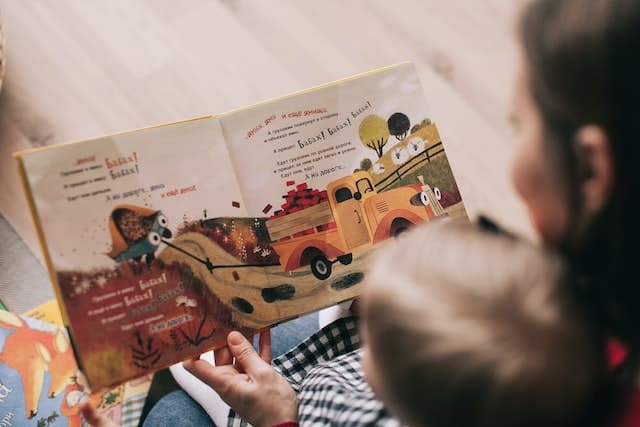Four-year-olds are at a stage where they are curious about the world around them and are constantly learning new things. Reading is one of the essential skills that they will need as they grow older. However, the question is, can 4-year-olds read?
The answer is yes and no. While some 4-year-olds can read simple words and sentences, others may not be able to read at all. This is because reading skills and milestones for 4-year-olds vary from child to child.
Understanding the developmental stage of 4-year-olds is crucial in determining their reading skills and milestones. In this article, we will explore the basics of reading for 4-year-olds, language skills in 4-year-olds, the role of parents and teachers in teaching reading, choosing books for 4-year-olds, and more.
Key Takeaways
- Reading skills and milestones for 4-year-olds vary from child to child.
- Understanding the developmental stage of 4-year-olds is crucial in determining their reading skills.
- The role of parents and teachers is essential in teaching reading to 4-year-olds.
The Basics of Reading for 4-Year-Olds

Learning to read is an important milestone in a child’s development. Although not all 4-year-olds can read, many are starting to develop the necessary skills to become early readers.
At this age, children are typically learning to recognize letters and the sounds they make. They may also be able to identify familiar words and may enjoy looking at picture books.
To help 4-year-olds develop their reading skills, parents and teachers can engage them in activities that promote language and literacy. This can include reading aloud to them, encouraging them to write and draw, and singing songs with rhyming words.
It is important to note that every child develops at their own pace, and some may not be ready to read until they are closer to age 5 or even older. It is also important to focus on the joy of reading and not put too much pressure on a child to read before they are ready.
Parents and teachers can look for signs of reading readiness, such as a child being able to recognize letters and numbers, having good hand-eye coordination, and being able to take turns in conversation. It is also helpful if a child is potty trained and can sit still for short periods of time.
Overall, the key to helping 4-year-olds develop their reading skills is to create a supportive and engaging environment that promotes language and literacy.
By providing opportunities for children to explore books, practice writing and drawing, and engage in language-rich activities, parents and teachers can help set children on a path towards reading success.
Understanding the Developmental Stage of 4-Year-Olds
Four-year-olds are at a critical stage of development. They are no longer toddlers, but they are not yet school-age children. At this age, children are developing both physically and mentally.
It is important to understand the developmental milestones of four-year-olds to help them grow and thrive.
1. Emotional Development
Four-year-olds are learning to express their emotions. They are becoming more aware of their feelings and are able to communicate them better. They may still have tantrums, but they are becoming less frequent. Children at this age are also learning to understand the emotions of others.
2. Social-Emotional Development
Four-year-olds are developing social skills. They are learning to play with others and share toys. They are also learning to take turns and cooperate with others. Children at this age are becoming more independent and are starting to assert their own opinions.
3. Cognitive Development
Four-year-olds are developing their cognitive skills. They are learning to recognize colors, shapes, and letters. They are also learning to count and understand simple math concepts. Children at this age are becoming more curious about the world around them and are asking lots of questions.
4. Physical Development
Four-year-olds are becoming more physically active. They are learning to run, jump, and climb. They are also developing fine motor skills, such as using scissors and drawing shapes. Children at this age are becoming more coordinated and are able to participate in organized sports and activities.
Overall, four-year-olds are at a critical stage of development. They are learning and growing in many ways. It is important to provide them with a safe and supportive environment to help them reach their full potential.
Reading Skills and Milestones for 4-Year-Olds

At the age of 4, children are typically able to recognize letters and some words. They may also be able to identify the sounds associated with those letters. While some 4-year-olds may be able to read simple words and sentences, it is not expected that all children at this age can read independently.
Early literacy skills play an important role in the development of reading skills. 4-year-olds who have been exposed to books and reading are more likely to develop a love for reading and become successful readers. It is important for parents and caregivers to read to their children regularly and encourage them to practice reading.
Some reading milestones for 4-year-olds include:
- Recognizing and naming letters of the alphabet
- Recognizing and naming some sight words
- Identifying the sounds associated with letters
- Recognizing the difference between letters and words
- Understanding that text is read from left to right and top to bottom
- Recognizing and understanding basic punctuation marks such as periods and question marks
It is important to note that every child develops at their own pace and some children may not meet these milestones until later. However, with consistent exposure to reading and encouragement, most children will develop the necessary reading skills by the time they reach school age.
Language Skills in 4-Year-Olds
At four years old, most children have developed a significant amount of language skills. They have a vocabulary of around 1,500 words and can form sentences of five or more words. They are also able to understand and follow more complex instructions.
In terms of phonics, four-year-olds are able to recognize and produce rhyming words. They are also able to identify the beginning and ending sounds of words. These skills are important for developing reading skills later on.
To further develop language skills, it is important for children to be exposed to a variety of language-rich environments. This includes reading books, singing songs, and engaging in conversation with adults and peers.
Communication is also an important aspect of language development. Four-year-olds are able to engage in conversations and express their thoughts and feelings. They are also able to understand and respond appropriately to social cues and nonverbal communication.
Overall, while every child develops at their own pace, most four-year-olds have developed a strong foundation of language skills and are on track for further language development.
The Role of Parents and Teachers

Parents and teachers play a crucial role in helping children develop reading skills. By sharing books and reading aloud to children, parents can instill an early love of reading and help children develop important literacy skills. Teachers, on the other hand, can provide structured instruction and support to help children learn to read.
Effective teaching requires clear communication between parents and teachers. Parents should communicate with teachers about their child’s reading level and any concerns they may have.
Teachers should also communicate with parents about their child’s progress and provide guidance on how parents can support their child’s reading development at home.
Starting school is an important milestone for children, and it is important for parents and teachers to work together to ensure that children have the support they need to succeed.
Teachers can provide a supportive and engaging learning environment, while parents can provide encouragement and support at home.
In conclusion, parents and teachers play a critical role in helping children develop reading skills. By working together and communicating effectively, they can provide the support and guidance that children need to become confident and successful readers.
Choosing Books for 4-Year-Olds
Choosing books for 4-year-olds can be a daunting task, but it doesn’t have to be. With so many options available, it’s important to find books that are both engaging and appropriate for their age group.
When selecting books for 4-year-olds, it’s important to consider their interests and reading level. Picture books are a great option for this age group, as they often feature colorful illustrations and simple stories that are easy to follow. Look for books that feature familiar characters or topics that your child enjoys, such as animals, nature, or superheroes.
Another option for 4-year-olds are chapter books. While these books may be too advanced for them to read on their own, they can be great for reading together as a family. Look for books with short chapters and plenty of illustrations to keep your child engaged.
When it comes to authors, there are plenty of great options for 4-year-olds. Some popular authors for this age group include Dr. Seuss, Eric Carle, and Mo Willems. These authors are known for their engaging stories and colorful illustrations that are sure to capture your child’s attention.
Ultimately, the key to choosing books for 4-year-olds is to find books that are both engaging and appropriate for their age group. By considering their interests and reading level, you can help foster a love of reading that will last a lifetime.
Teaching Reading to 4-Year-Olds
Teaching reading to 4-year-olds can be a challenging task, but it is not impossible. It requires patience, creativity, and a good understanding of the child’s individual needs and learning style.
One of the first steps in teaching reading to 4-year-olds is introducing them to the letters of the alphabet. This can be done through songs, games, and other fun activities that make learning enjoyable. Once the child is familiar with the letters, the focus can shift to teaching them the sounds that each letter makes.
Phonics is an effective method of teaching children how to read, and it can be especially useful for 4-year-olds. Phonics involves teaching children how to decode words by breaking them down into their individual sounds.
This can be done through games and activities that involve matching letters to their corresponding sounds.
Sight words are also an important part of teaching reading to 4-year-olds. These are words that children should be able to recognize on sight, without having to sound them out. Sight words can be introduced through flashcards, games, and other activities that make learning fun and engaging.
Decoding is another important skill that 4-year-olds need to learn in order to read. Decoding involves using phonics to sound out words that are unfamiliar. This can be done through games and activities that involve reading simple sentences and paragraphs.
In conclusion, teaching reading to 4-year-olds requires patience, creativity, and a good understanding of the child’s individual needs and learning style. By introducing them to the letters of the alphabet, teaching them phonics, sight words, and decoding, children can develop the skills they need to become successful readers.
Writing and Other Academic Skills
While four-year-olds are still developing their writing skills, they are capable of learning the basics of writing. They may be able to write their names and simple words like “mom” and “dad.” However, they may still struggle with letter formation, spelling, and sentence structure.
It is important to encourage children to practice writing and provide them with the necessary tools to do so. This includes providing them with pencils, crayons, and paper. Parents can also help their children by practicing writing with them and providing positive feedback.
In addition to writing skills, four-year-olds may also be developing their math skills. They may be able to count to 10, recognize numbers, and understand basic addition concepts. Parents can help their children develop these skills by providing them with counting games and activities.
Four-year-olds may also be learning about shapes and colors. They may be able to recognize and name basic shapes like circles, squares, and triangles. Parents can help their children develop this skill by providing them with shape sorting games and activities.
Overall, while four-year-olds are still developing their academic skills, they are capable of learning the basics of writing, math, and shapes. Parents can help their children develop these skills by providing them with the necessary tools and positive encouragement.
Social and Emotional Development in 4-Year-Olds
At the age of 4, children experience significant changes in their social and emotional development. They become more aware of their emotions and the emotions of others, which helps them develop empathy and respect for others.
Social-emotional development is an essential part of a child’s overall development. It involves learning how to interact with others, how to express emotions, and how to control behavior. Four-year-olds are capable of understanding social cues and developing relationships with others.
They begin to understand the concept of sharing and taking turns, which helps them develop social skills.
Respect is another crucial aspect of social development. Four-year-olds are capable of showing respect to others, including adults and peers. They learn to listen to others and follow rules, which helps them develop self-control and obedience.
Self-control is an essential skill that four-year-olds develop as part of their emotional development. They learn to regulate their emotions and control their behavior, which helps them interact with others positively. Developing self-control also helps children manage stress and anxiety.
In conclusion, social and emotional development is a critical aspect of a child’s overall development. Four-year-olds experience significant changes in their social and emotional development, which helps them develop empathy, respect, self-control, and obedience.
Conclusion
In conclusion, the question of whether 4-year-olds can read is a complex one. While some children may show signs of early reading skills at this age, it is not typical for most children to be able to read fluently.
Research has shown that early exposure to reading and literacy activities can have a positive impact on a child’s language development and future reading abilities. However, it is important to note that every child develops at their own pace and there is no one-size-fits-all approach to teaching reading.
Parents and caregivers can support their child’s literacy development by reading aloud to them regularly, providing access to age-appropriate books, and engaging in activities that promote phonemic awareness and letter recognition.
It is also important to create a positive and supportive environment that encourages children to explore and enjoy reading.
Overall, while it is not typical for 4-year-olds to be able to read fluently, with the right support and encouragement, children can develop strong literacy skills that will serve them well throughout their lives.
Frequently Asked Questions
What level should a 4 year old be reading?
At 4 years old, most children are expected to recognize letters and their sounds. They may also be able to read simple words and short sentences. However, it is important to keep in mind that every child develops at their own pace, so there is no set level that a 4 year old should be reading.
How many sight words should a 4 year-old know?
A 4 year old should be able to recognize and read a few basic sight words, such as “the”, “and”, “is”, “it”, “in”, “to”, “you”, and “me”. However, again, it is important to remember that every child develops differently and at their own pace.
How to teach 4 year old to read?
To teach a 4 year old to read, it is important to start by introducing them to the alphabet and the sounds that each letter makes. You can also use picture books with simple words and sentences to help them practice reading. It’s important to make reading fun and engaging for the child, and to be patient and encouraging as they learn.
What should a 4 year old know academically?
Academically, a 4 year old should have a basic understanding of numbers, shapes, colors, and letters. They should also be able to follow simple instructions and have good communication skills. However, again, every child develops at their own pace, so it’s important not to compare them to others.
What’s the earliest a child can read?
The earliest a child can read varies from child to child, but some children may begin reading as early as 3 years old. However, it’s important to keep in mind that this is not the norm and most children begin reading around 5-6 years old.
How many words should a 5 year old read?
A 5 year old should be able to read and recognize a few hundred words, including sight words and simple words with phonetic spelling. However, again, it’s important to remember that every child develops at their own pace and there is no set number of words that a 5 year old should be reading.

Iesha is a loving mother of 2 beautiful children. She’s an active parent who enjoys indoor and outdoor adventures with her family. Her mission is to share practical and realistic parenting advice to help the parenting community becoming stronger.
